Five
CHURCHES AND SCHOOLS
As residential development began to flourish in the North Park area around 1910, the need for religious institutions and elementary schools close to home grew. Many religious institutions started in private homes. As congregations of various faiths expanded, they purchased parcels for eventual construction of a place to worship. They often held their first services in tents. When the financial resources were finally obtained, they built churches, synagogues, auditoriums, and social halls. Some congregations expanded their role in the community by establishing schools as well, such as St. Patrick’s Catholic parish. The Augustinian Order established St. Augustine as a high school for boys in 1922. Other early churches include North Park Community, Immanuel Evangelical, Park Villas Congregational (later Plymouth Congregational), Trinity Methodist, North Park Baptist, Grace Lutheran, and St. Luke’s Episcopal. Beth Jacob Orthodox Synagogue was built in 1950, and Tifereth Israel Synagogue was built in 1948. Although these two congregations left North Park in the 1970s, their buildings still serve religious purposes. Early public elementary schools include Jefferson, Garfield, and McKinley. Although technically not in North Park, Hoover High School and San Diego High School have educated many of the community’s teenagers. Not all religious institutions and schools that have helped shape North Park could be included in this chapter, but their worthy stories are all reflected in those highlighted.

ORIGINAL TRINITY CHURCH, 1915, AND NEW CHURCH, 1960S. A visitor to the 1915 Panama-California Exposition, Rev. Walter Grant wanted to stay in San Diego and decided that the residential area around Upas and Thirtieth Streets could use a Methodist Episcopal congregation. The first chapel (above) was placed on borrowed land near Upas and Thirtieth Streets. Later, the chapel moved to land purchased at Grim Avenue and Thorn Street. In 1922, the congregation had outgrown the original chapel and two side wings and decided to build a larger church. The new church at 3030 Thorn Street (left) was dedicated on November 2, 1924. (Both, courtesy of Trinity Methodist Church.)


TRINITY CHURCH CHOIR, 1930S, AND CHURCH INTERIOR, C. 1960S. The above photograph of the Trinity Methodist Church choir at 3030 Thorn Street is from about 1932. The choir members are identified by last name as, from left to right, (first row) Calkins, Oberg, Crow, Fitzpatrick, and Doty; (second row) Ditmar, Howard, Miller, Reverend Mahood, Jacobson, Ellers, Black, and Franklin. Right, the interior of Trinity Methodist Church is pictured with a later choir. (Both, courtesy of Trinity Methodist Church.)

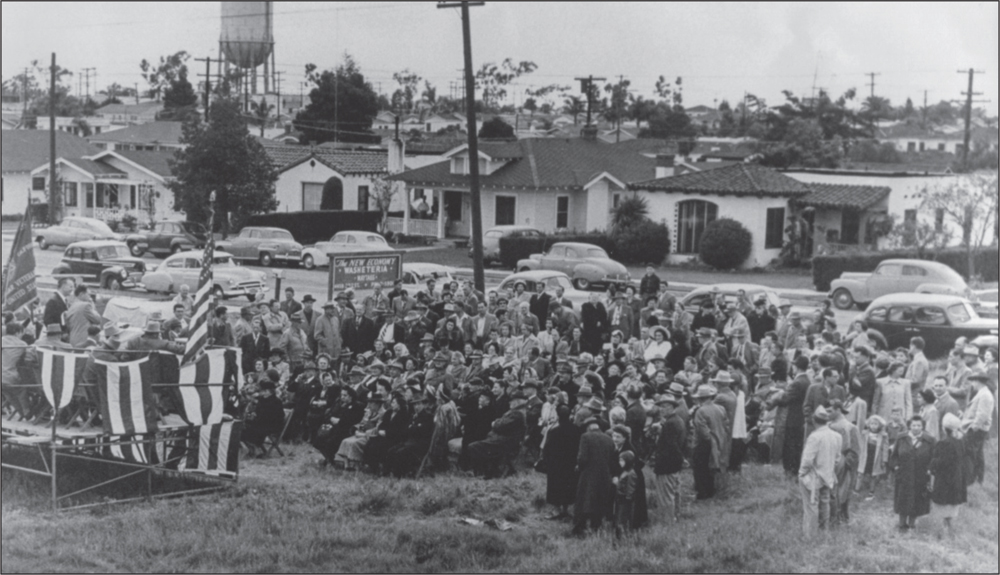
SYNAGOGUE GROUNDBREAKING, 1950. The Beth Jacob Orthodox Synagogue broke ground on March 26, 1950. Located on Thirtieth Street between Meade and Monroe Avenues, it was one of two Jewish congregations in North Park during the mid-20th century. The building is now home to St. John Garabed Armenian Church. Many structures in the photograph are still standing, including several houses on Thirtieth Street and the water tower. (Courtesy of the Covington family.)
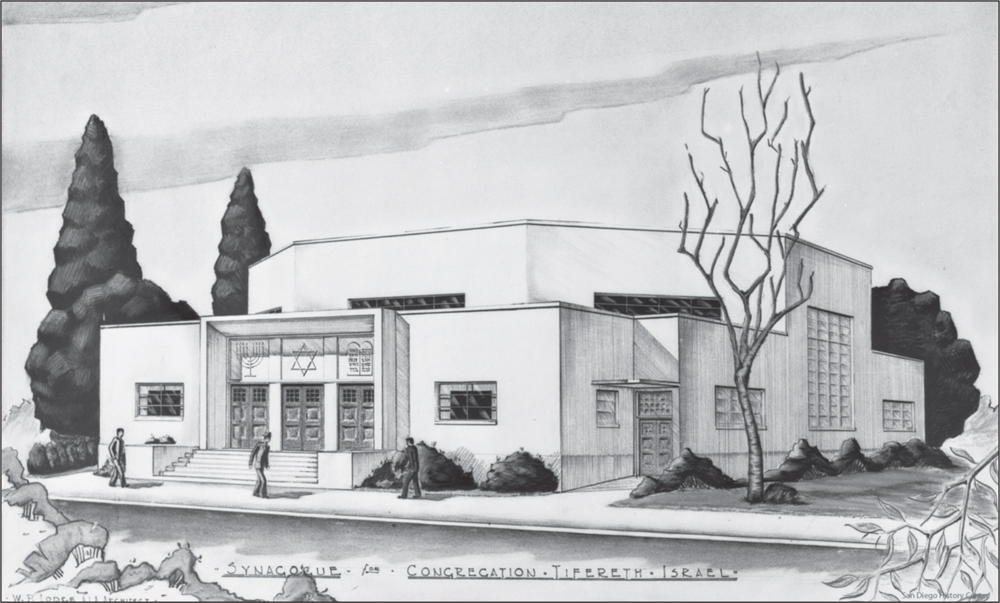
ARCHITECTURAL DRAWING OF TIFERETH ISRAEL SYNAGOGUE, 1948. The Tifereth Israel Congregation was established in 1906. To serve a growing Jewish population, the congregation built a new synagogue at Howard Avenue and Thirtieth Street in 1948. In the late 1970s, the congregation moved to a larger facility in the San Carlos area and sold the building on Howard Avenue to Covenant Presbyterian Church.

PLYMOUTH CONGREGATIONAL CHURCH, 1958. Architect William Wheeler designed this Spanish Revival–style church in 1922. Damaged by a fire in 1965, it was rebuilt in 1977 in its current Modernist style. It has always played a major role in North Park. The first 3,000-book North Park Public Library was located in the church buildings in 1924; currently, both Head Start and Alcoholics Anonymous programs are held there. (Courtesy of Plymouth Congregational Church.)

ST. PATRICK’S CHURCH, 1929. Architect Frank Hope Jr. designed this Romanesque Revival–style church, which was completed in March 1929 in time for Easter services. The elaborate concrete building features a west-facing rose window with saints depicted in stained glass. The parish house next door (right) was restored in 2012 to its original Craftsman glory with volunteer assistance from parish members.

ST. PATRICK’S SCHOOL, 1944. This wooden building, which served as the original church and hall, was constructed in 1922 at Dwight and Ray Streets. In 1944, the building was renovated as a temporary two-room school by enlarging exit doors and adding windows and plumbing. In the fall of that year, two nuns taught 50 students divided into three grades. Because of limited space, lunch hour took place on the curb along Dwight Street, which was closed during school hours (below). Father John Burns, a professor from Villanova College who became St. Patrick’s fifth pastor in 1943, was the driving force behind establishing a school for the parish. The building was sold and removed in 1949 when a new parish school was developed. (Both, courtesy of St. Patrick’s Church.)


ST. PATRICK’S SCHOOL EXPANSION, 1948. In September 1947, the school was becoming extremely crowded, with five nuns and 181 students in seven grades. Father Burns wrote to Bishop Charles Buddy, “We have the opportunity to secure a fairly large Quonset Hut from the State Board of Education for $535.00.” The first step was to remove the existing building (above). The hut was successfully added in February 1948 (below) and hosted graduation parties as well as classes. (Both, courtesy of St. Patrick’s Church.)


ST. PATRICK’S SCHOOL COMPLEX, 1949. Expansion of the school, a convent for the teaching nuns, and additional playground space remained a vision for the parish. The new complex of school buildings, a parish hall, and convent opened in the fall of 1949, with seven nuns teaching 254 students in eight grades. This view is along Ray Street to the right at Capps Street. (Courtesy of St. Patrick’s Church.)

ST. PATRICK’S STUDENTS, 1952. Dapper school-safety patrol boys stop traffic along Thirtieth Street at Dwight Street so students can cross the busy street. (Courtesy of St. Patrick’s Church.)

LETTER TO MRS. KENNEDY, 1963. Sister Mary Cletus of St. Patrick’s Convent in North Park wrote this heartfelt letter of condolence to Jacqueline Kennedy on November 24, 1963. Sister Cletus referenced the thrilling experience of seeing President Kennedy in his motorcade that had traveled along San Diego’s El Cajon Boulevard in June. The reply from Mrs. John F. Kennedy stated, “Mrs. Kennedy is deeply appreciative of your sympathy and grateful for your thoughtfulness.” (Both, courtesy of St. Patrick’s Church.)


JEFFERSON ELEMENTARY SCHOOL, 1924. The architecture of the Jefferson school has gone through many changes since opening in the heart of North Park on Utah Street in 1913. The first phase of the school was a single-story, four-room building with French doors. For a century, Jefferson Elementary has strived for academic excellence—a tradition inspired by Pres. Thomas Jefferson, who founded the University of Virginia after his presidency.

JEFFERSON KINDERGARTEN, 1916. Mable and Myra Horton, twin sisters who lived in a house across from the school on Utah Street, are fifth and sixth from the left in the front row of Jefferson Elementary School’s 1916 kindergarten class. The girls continued at Jefferson through the sixth grade, attended the first class at Roosevelt Junior High School, and graduated from San Diego High School in 1928. (Courtesy of Donna Couchman.)

JEFFERSON SIXTH GRADE GRADUATION, 1955. Myra Horton’s daughter Donna Couchman followed in her mother’s footsteps. In this sixth-grade graduation photograph of well-dressed students posing on the front lawn of Jefferson Elementary School, Couchman is the third girl from the left in the second row. She graduated from San Diego High School in 1960. (Courtesy of Donna Couchman.)
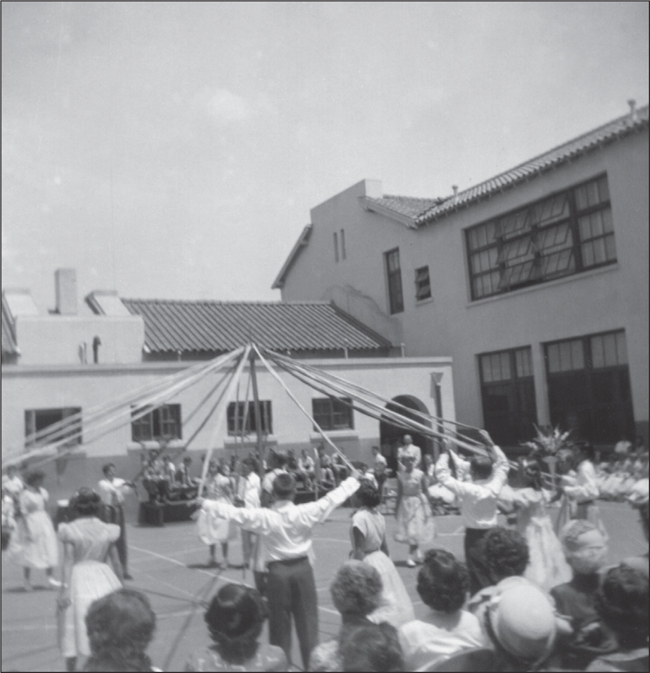
JEFFERSON ELEMENTARY MAYPOLE, 1955. In a charming ceremony reflective of the times, graduating sixth graders at Jefferson Elementary School dance around a maypole while proud parents watch. The courtyard of the school behind the original central building and one of the side wings can be seen in this photograph. (Courtesy of Donna Couchman.)

GARFIELD SCHOOL, C. 1923. This school has evolved since opening in 1913 south of El Cajon Boulevard and later moving north. Originally an elementary school, the curriculum was refocused in the 1970s to become Garfield Continuation High. In 1999, Garfield High relocated toward downtown and Garfield Elementary reopened for North Park youth. To honor the school’s history, the name Garfield was kept, despite there being two Garfield schools in San Diego.

MCKINLEY ELEMENTARY SCHOOL, 1928. Built in 1924, McKinley Elementary School’s inaugural class was welcomed into all 13 classrooms on February 2, 1925. Almost immediately, the school began adding facilities to meet increasing community needs. This original two-story building designed by Richard Requa and Herbert Jackson was replaced in 1973 due to earthquake safety concerns. Generations of families have attended the school and remain active in the McKinley Alumni.

WE DO GOOD WORK, 1954. Young McKinley students are encouraged to do their best as they carefully select the most appropriate crayon for the task. When they graduate, perhaps they will sing the class song written by 1951 sixth-graders Lois Fishburn and Nancy Zitlau, which begins: “Goodbye McKinley School, we’ve all enjoyed the years we’ve been here. Goodbye to friends we’ve met and to our teachers dear.” (Courtesy of McKinley School.)

LEARNING ABOUT THE AIRPORT, 1953. McKinley students in Miss Hahn’s Room 6 learn about Lindbergh Field through models, photographs, displays, and audiotapes on headphones. After the school’s construction in 1924, multiple classrooms, the outdoor Greek Bowl, a cafeteria—and later a newer cafeteria, kitchen, and auditorium complex—were added. (Courtesy of McKinley School.)

MCKINLEY HALLOWEEN CARNIVAL, 1955. The Halloween Carnival organized by the PTA featured a haunted house, cakewalk, games, and booths selling items handmade by parents. The children’s saddle shoes, Mary Jane shoes, princess costumes, hair made curly with bobby pins, cowboy shirt, and World War II helmet give the era away. The costumes may have changed now, but the joy this holiday brings to schoolchildren has not. (Courtesy of McKinley School.)

MCKINLEY CROSSING GUARDS, 1956. These neatly dressed boys in their distinctive sweaters and caps take their safety-patrol duties seriously. Bobby Fishburn, Lois Fishburn’s brother, is in front holding the stop sign. Helping assure that students crossed streets safely was an honor in schools throughout San Diego County. (Courtesy of McKinley School.)

ST. AUGUSTINE HIGH SCHOOL, 1928. This private Catholic school for boys began on September 18, 1922, with 19 students meeting temporarily in Mission Hills. In 1923, the permanent school designed by Richard Requa (lower right) was built on Nutmeg Street, where it remains today. (Courtesy of St. Augustine High School.)

ST. AUGUSTINE CORE BUILDINGS, 1927. The school buildings designed by Richard Requa were described as “a monument of architecture embodying the most perfect type of Spanish Old Mission style” at the school’s opening. The San Diego Union reported that “Covered archways, quaint porticoes, hidden recesses and enclosed courts remind the visitor of ancient Spain or quaint Mexico.”
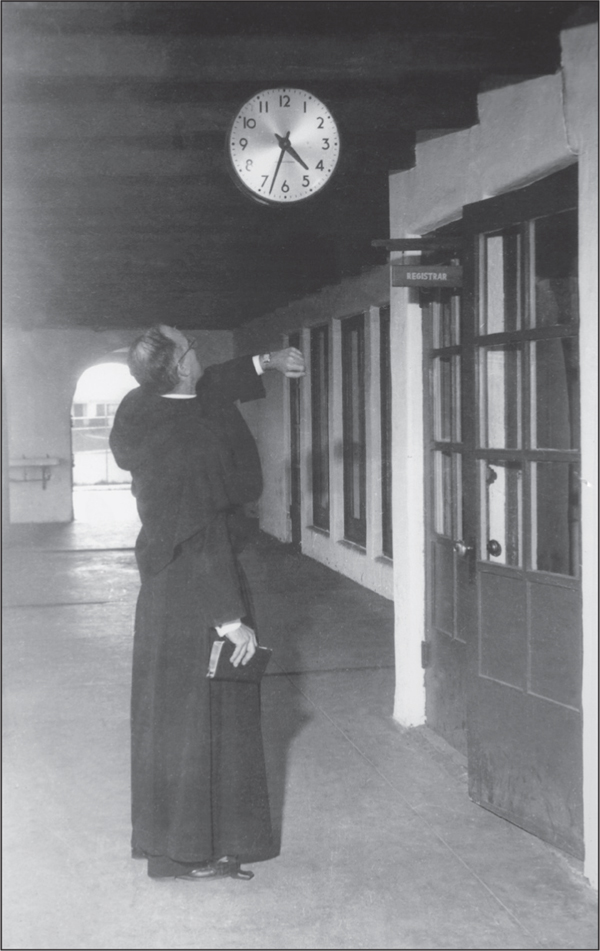
CLOCK CHECK IN THE CENTRAL COURTYARD, C. 1950S. St. Augustine High School is owned and operated by the Order of St. Augustine. Fr. David H. Ryan, a member of the order, is checking the clock in the central courtyard against his wristwatch. Members of the order pray each day at 5:00 p.m. (Courtesy of St. Augustine High School.)

ST. AUGUSTINE RADIO CLUB, 1950S. Fr. David H. Ryan (center) was a 1927 graduate of St. Augustine High School and taught at the school from 1940 to 1958 and 1970 to 1975. He is demonstrating radio equipment to students. (Courtesy of St. Augustine High School.)

ST. AUGUSTINE BASKETBALL, 1925 AND 2013. Sports have been an integral part of the experience at St. Augustine since it opened in 1922. The high school has won many San Diego County California Interscholastic Federation championships in multiple sports, and many graduates have gone on to perform at both the collegiate and professional level. Above are the members of the 1925 basketball team. It took 90 years, but St. Augustine celebrated its first state championship by winning the Division III state title with a 59-52 overtime victory over San Francisco Sacred Heart Cathedral High on March 23, 2013. St. Augustine had come close in 2005 but lost in the title game. Coach Mike Haupt and the 2013 team are pictured below. (Both, courtesy of St. Augustine High School.)


HERBERT HOOVER SENIOR HIGH SCHOOL, 1933. Principal Floyd Johnson opened Hoover’s doors to its first student body in 1930. He urged students to “let us dream for our school as we dream for ourselves.” About the school, Pres. Herbert Hoover wrote, “I shall hope that it may long and usefully serve the young men and women who enter in search of truth and of leadership in moral and spiritual ideals.”

LAYING THE CORNERSTONE FOR HOOVER HIGH SCHOOL, 1929. A large crowd assembles for the laying of the cornerstone of Hoover High School. The Masons donated a time capsule, and there was a Masonic ceremony for laying the cornerstone. After Hoover opened, North Park students were split between San Diego High School and Hoover High School.

HOOVER HIGH SCHOOL AERIAL VIEW, 1952. This aerial photograph shows the Hoover High School campus along El Cajon Boulevard. Between the two main classroom buildings was a small nicely landscaped courtyard often used as a location for yearbook and school-newspaper photographs. During the 1950s, one of the biggest sporting events each year in San Diego was the football game between Hoover High School and San Diego High School.

HOOVER HIGH SCHOOL TOWER DEMOLITION, JUNE 18, 1976. A two-ton wrecking ball swung into the five-story Hoover High School tower over a dozen times to make way for earthquake-resistant school construction. All 165 members of the first graduating class began the tradition of the Tower Book 46 years earlier, when they each signed the same leather bound book on the fifth floor to present to the school.

SAN DIEGO HIGH SCHOOL, 1951. One of the oldest public schools in California and the oldest in San Diego, the high school’s roots trace back to Russ School, an elementary school established in 1882. By the mid-1880s, population growth created a need for a high school. Both elementary and high school classes operated at the Russ School until 1893, when the curriculum was adjusted for high school education only.

ROOM 20 STUDY HALL AT SAN DIEGO HIGH SCHOOL, 1912. By 1902, Russ High School was overcrowded, and a new larger school was planned and renamed San Diego High School. Designed by F.S. Allen, it opened in April 1907 and was quickly nicknamed the “Grey Castle.” In the 1970s, the original school was demolished and replaced. The Grey Castle was the last part torn down in 1975.

AUTO CLASS AT SAN DIEGO HIGH SCHOOL, 1920S. Dating back to its days as Russ School, San Diego High School is the oldest school still on its original site. In this photograph, students are shown working on a car chassis and engine in automobile shop behind the main building of the Grey Castle.

SAN DIEGO HIGH SCHOOL GIRLS TENNIS TEAM, 1918. Although it would be more than 50 years before federal law mandated equality for girl’s sports with boy’s sports in high school athletics, young ladies always actively participated in sports. The scarves these girls are wearing were not part of a tennis uniform but were typical female fashion for San Diego High School through the 1920s.

AERIAL VIEW OF SAN DIEGO HIGH SCHOOL, 1926. This aerial photograph shows San Diego High School with the original single-deck Balboa Stadium and Russ Auditorium, which served as the civic auditorium. The school was located on land originally set aside for Balboa Park. Interstate 5 now extends across the top of the photograph. Balboa Stadium hosted many non-sporting events, including appearances by Charles Lindbergh, Pres. Franklin Roosevelt, and the Beatles.
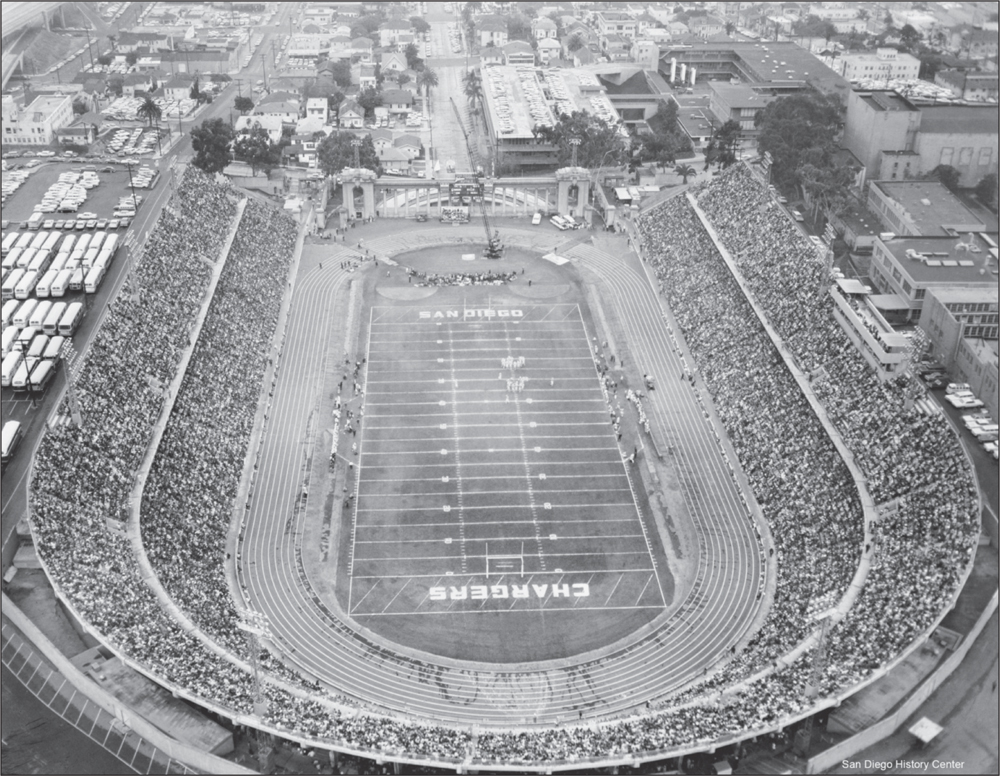
BALBOA STADIUM CHARGERS GAME, 1964. Balboa Stadium was expanded in 1961 by adding a second deck after the Chargers decided to move from Los Angeles to San Diego. The Chargers were San Diego’s first major-league sports team and had their ticket offices at the Lafayette Hotel on El Cajon Boulevard until San Diego Stadium opened in 1967. Balboa Stadium was demolished in the 1970s for seismic reasons.









































